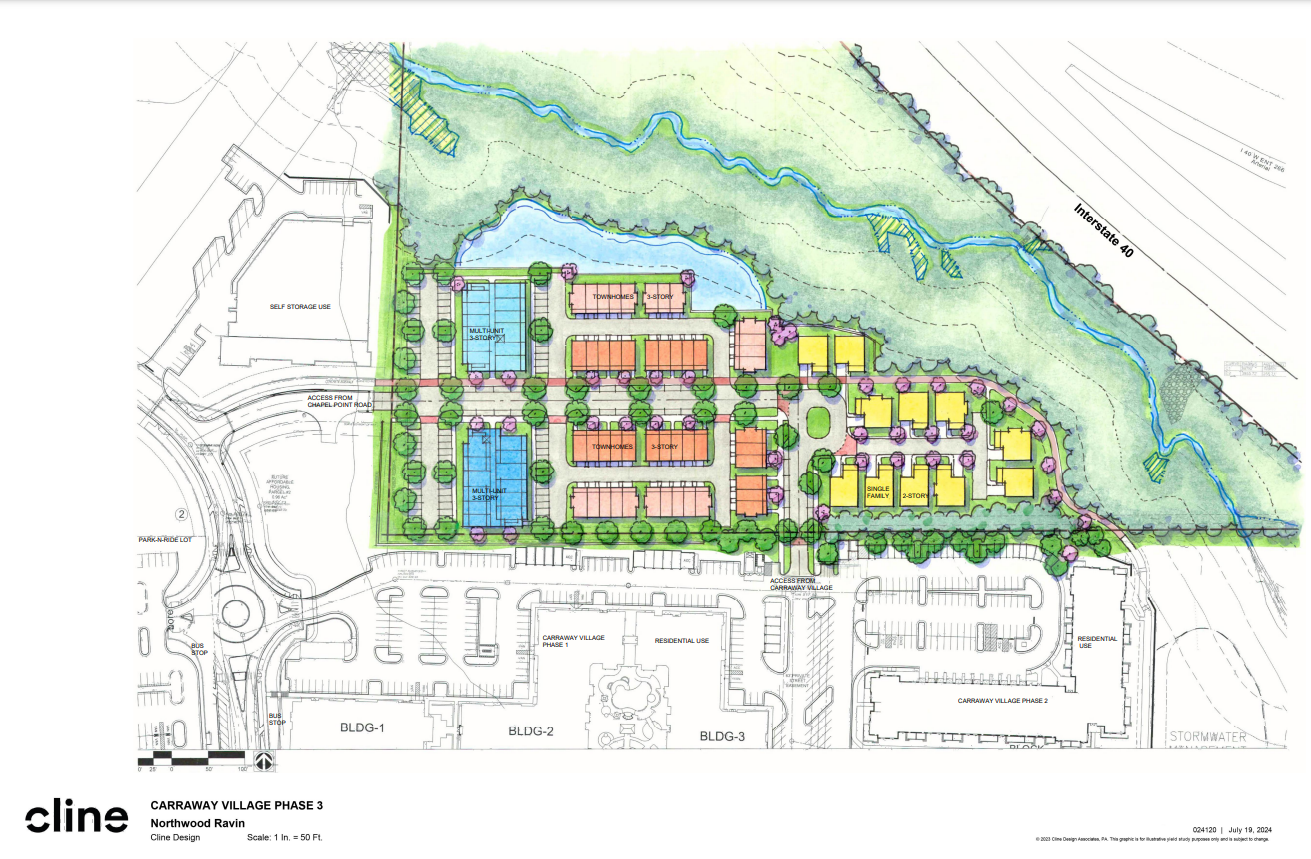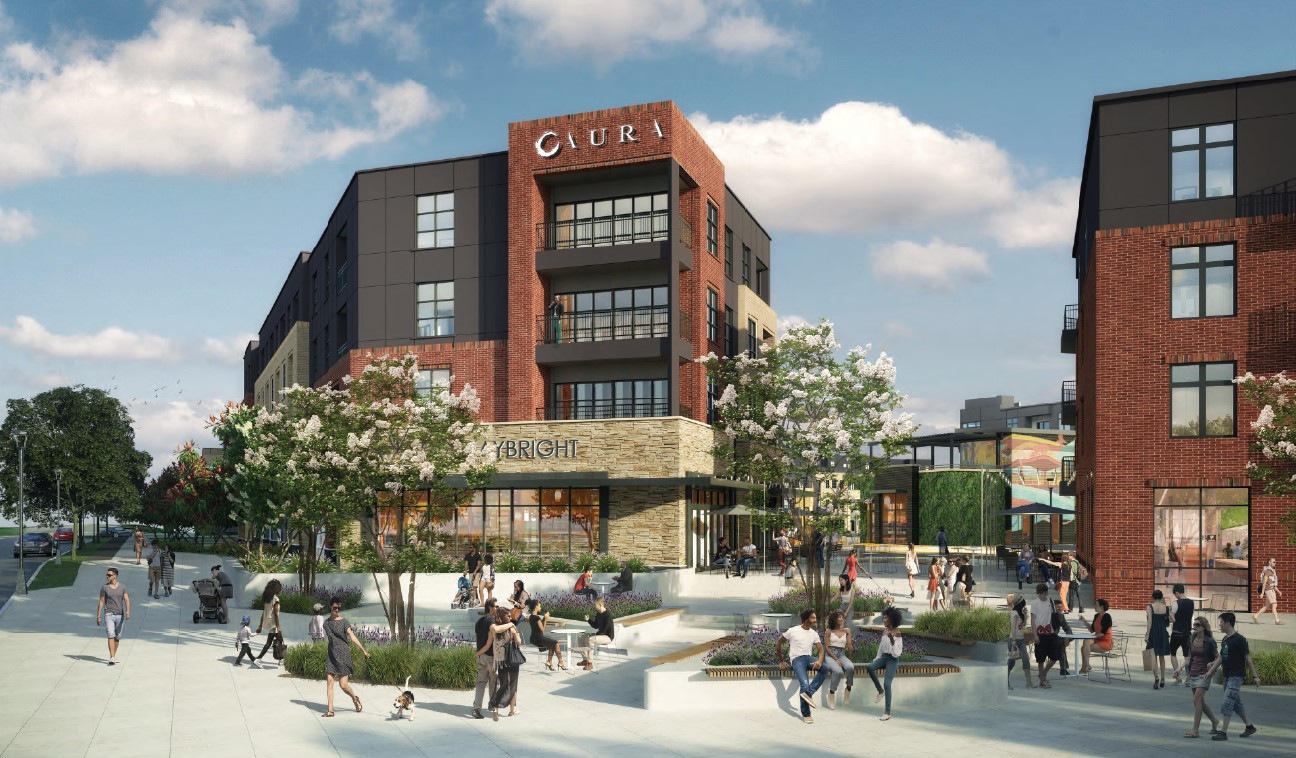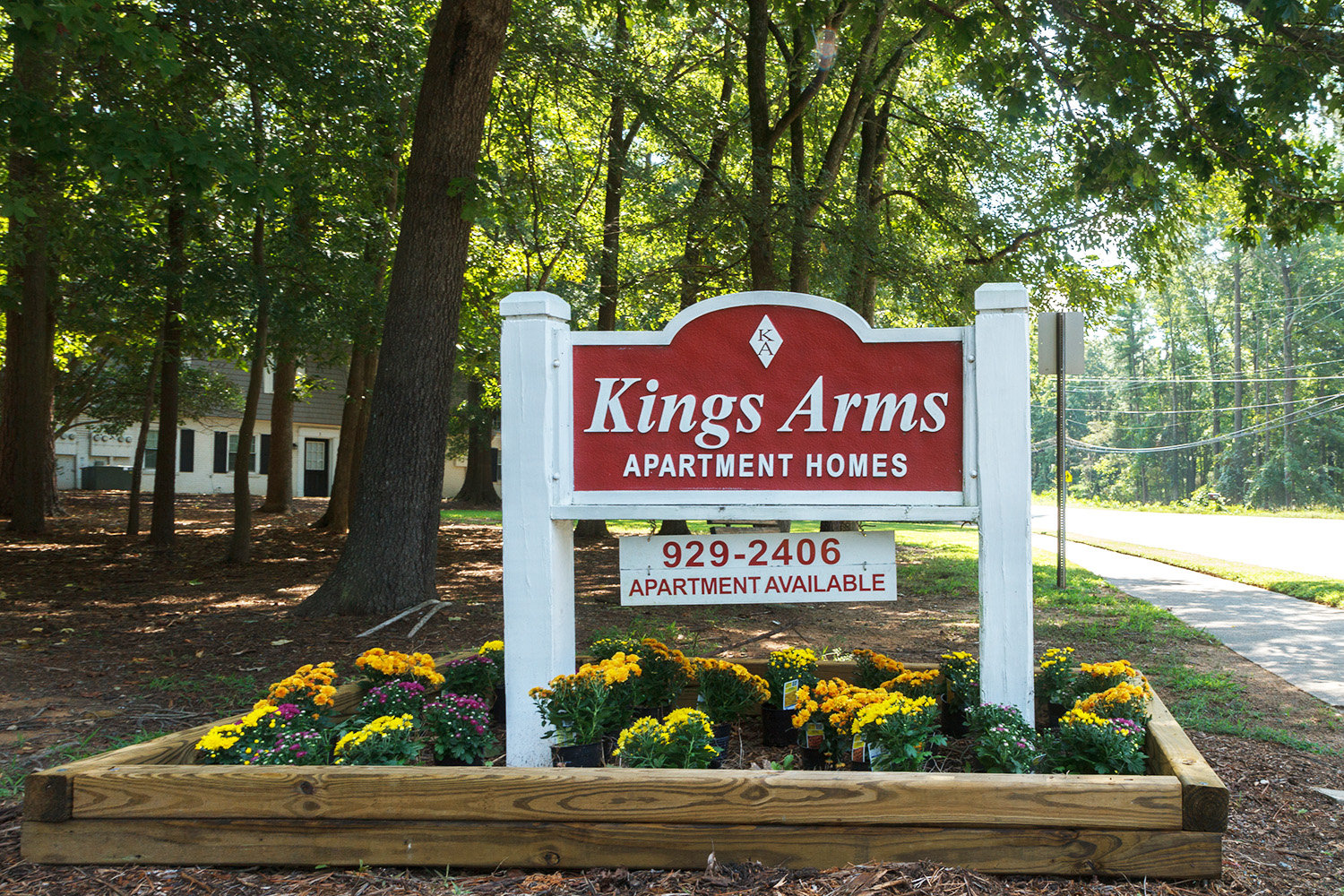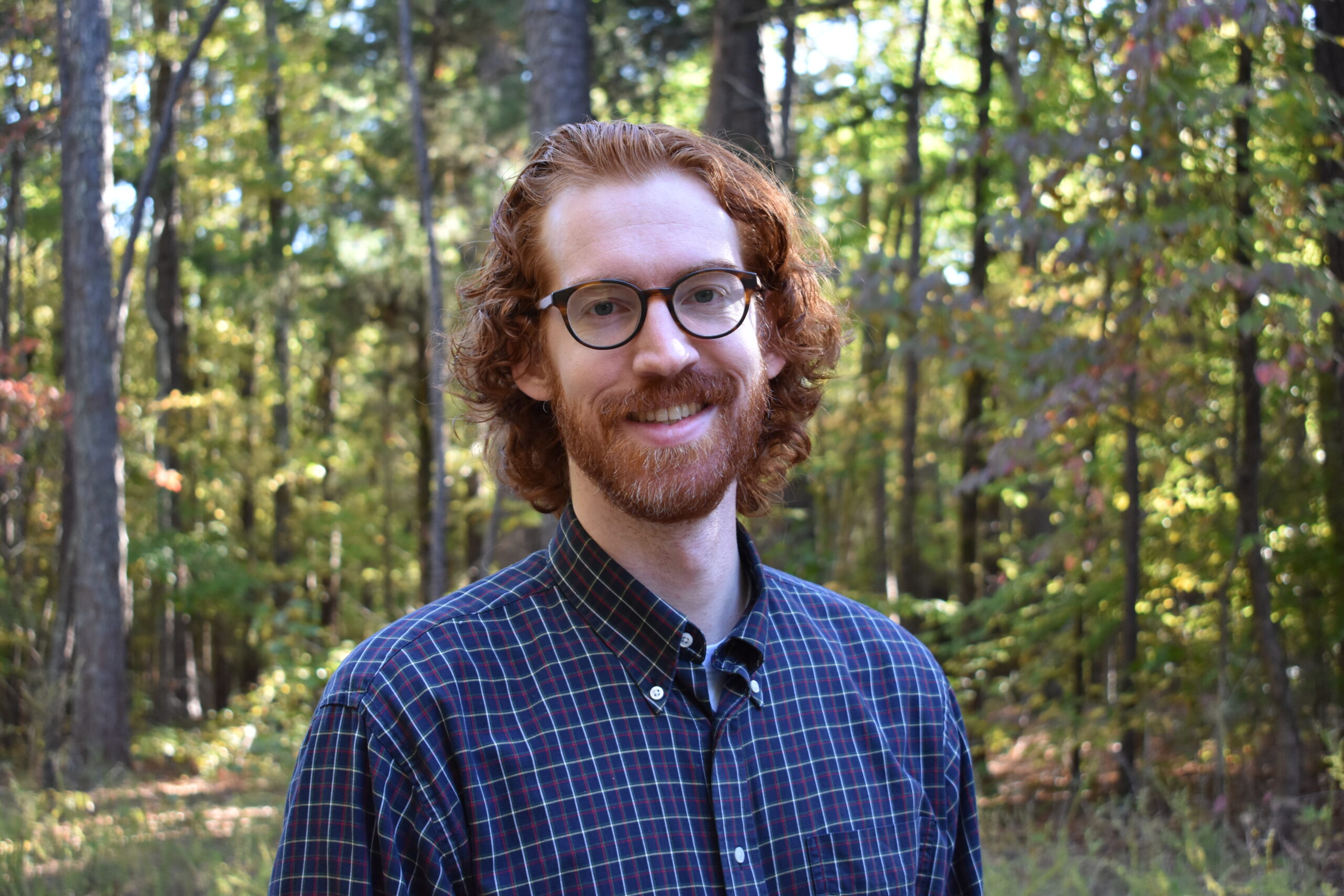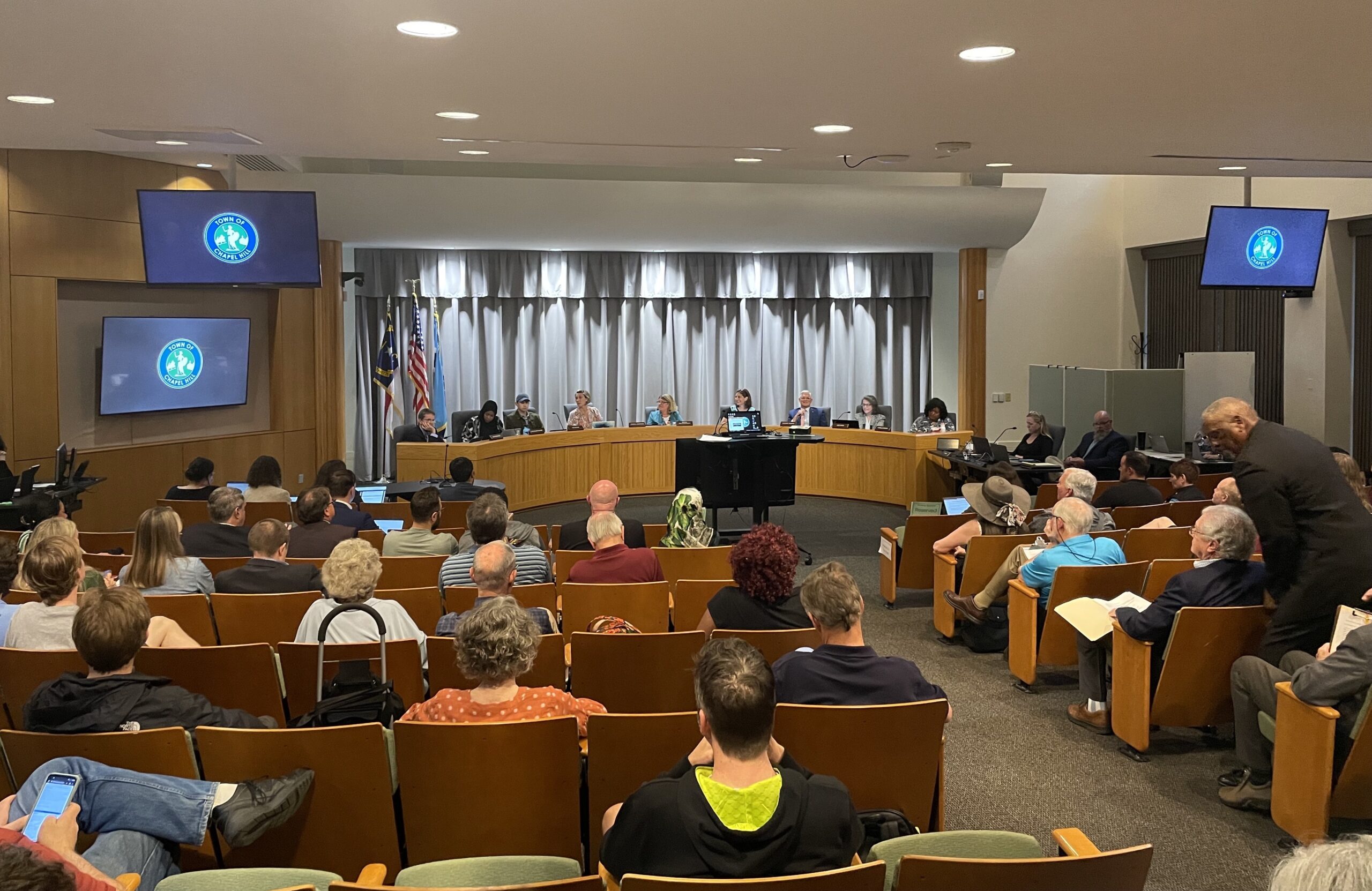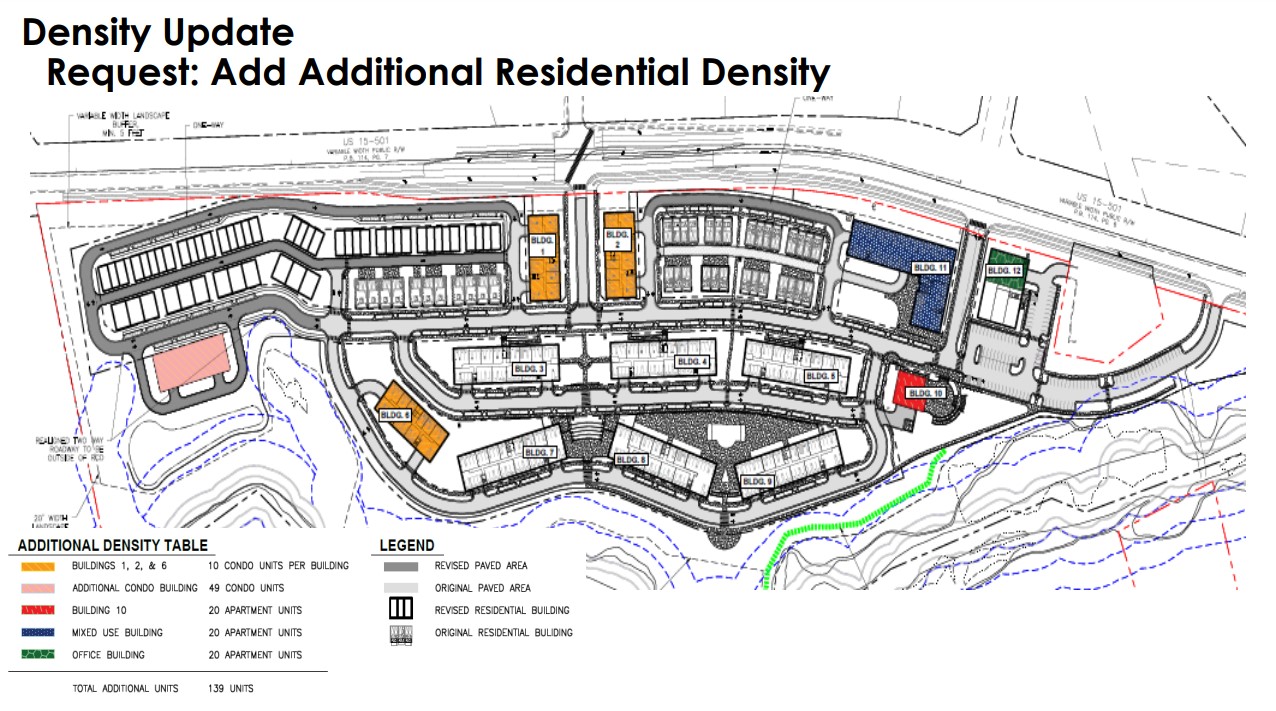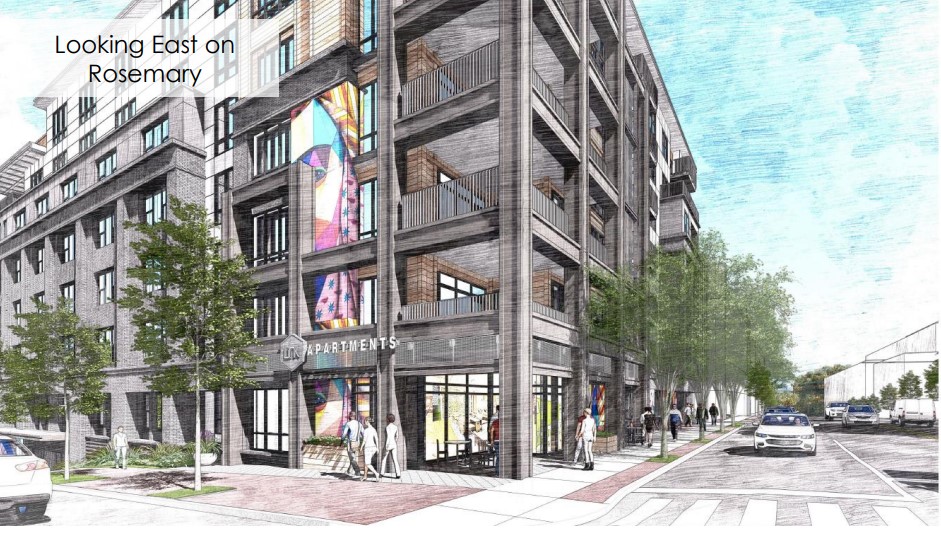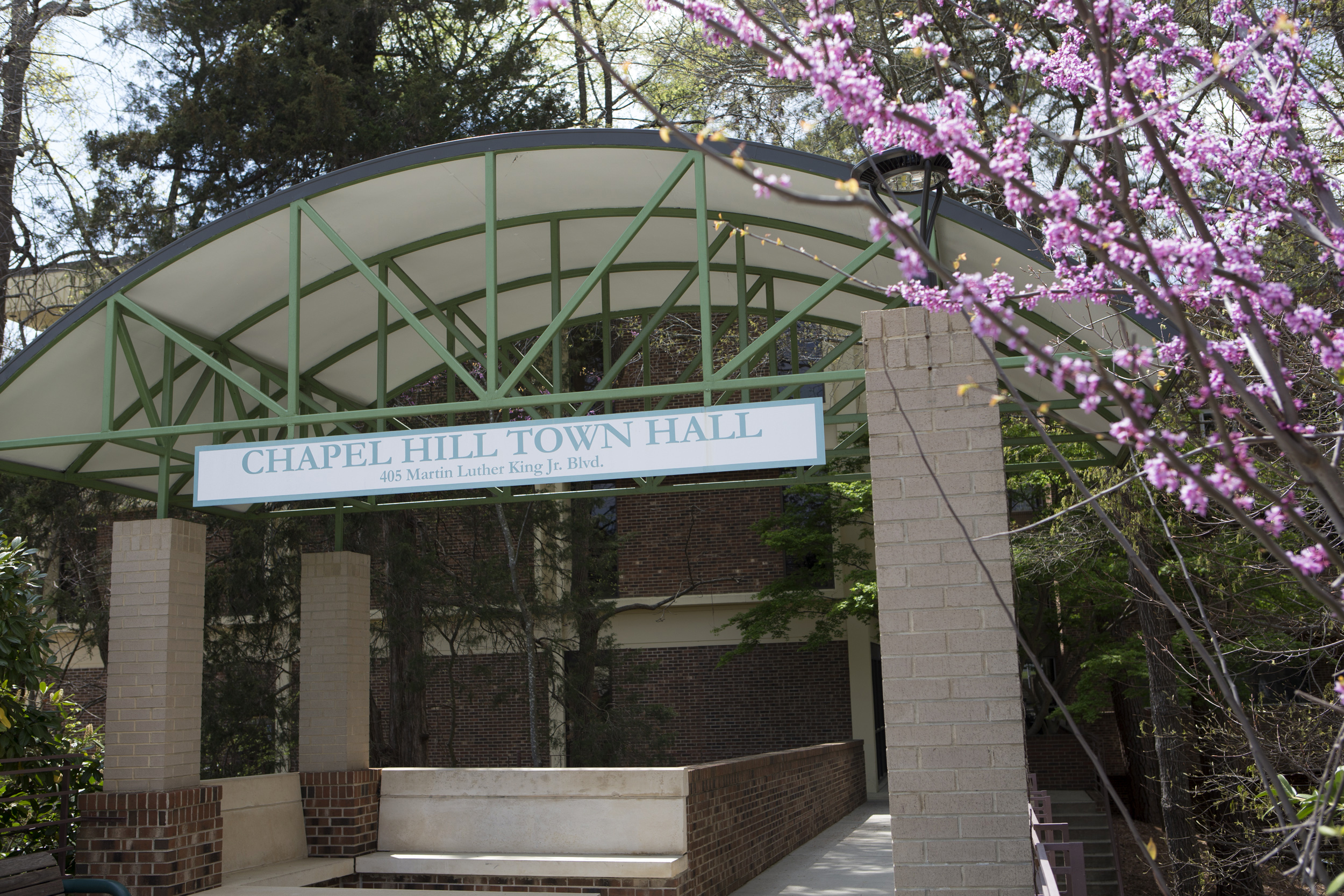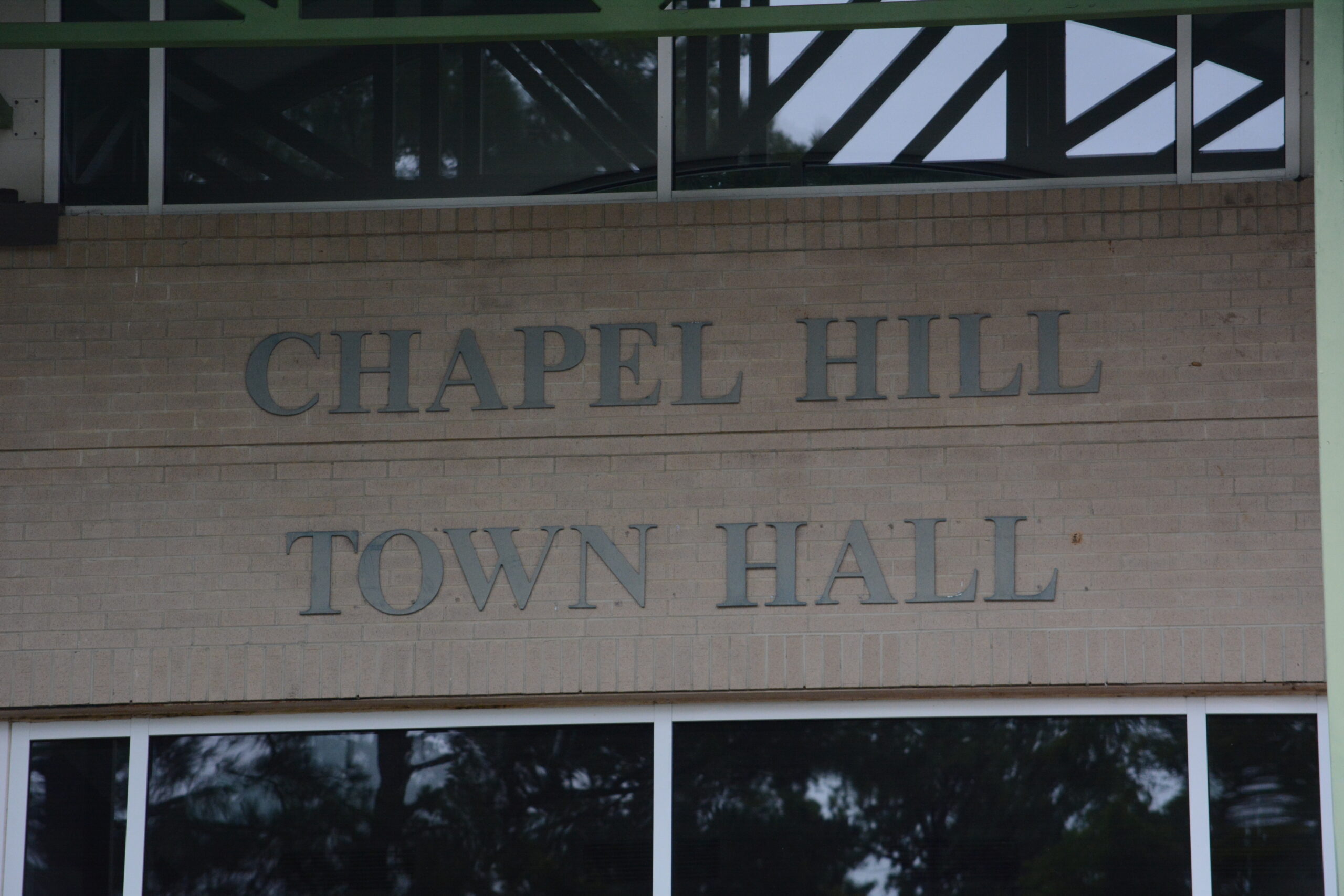During its final meeting before a summer break, the Chapel Hill Town Council approved changes to its Land Use Management Ordinance on Wednesday, which will allow for more duplexes and opportunities for housing diversity in single-family zoned areas.
Council members voted 6-3, with Council Members Jessica Anderson, Tai Huynh, Paris Miller-Foushee, Michael Parker and Karen Stegman joined Chapel Hill Mayor Pam Hemminger in the affirmative vote. Council Members Camille Berry, Amy Ryan and Adam Searing voted against the proposed measure.
Below is a transcript of the full comments and opinions shared by Chapel Hill Town Council members ahead of their vote, with some lightly edited for clarity. The order is the order in which elected officials spoke on Wednesday night. Video of the entire meeting can be found here.
Jessica Anderson
“We’re at a pivotal moment. Things are changing, as evidenced by our previous discussion about UNC Health relocating and expanding outpatient clinics to Eastowne. We’re also facing significant challenges in terms of housing affordability, climate change… the list goes on and on. And doing nothing or kicking the can down the road, it’s just not going to serve our community — current or future. The difficult and responsible thing to do is to take action in an informed way. While the topic at hand is housing, the fact of the matter is: this is just one piece of a much larger picture that is our future. And unfortunately, we’ve not gotten the message across, despite hours and hours and hours of staff time and many conversations with folks.
We’ve put many things in place in our town budget and various plans for infrastructure to support a thriving, diverse, and inclusive and sustainable community. For instance, over the past 50 years — through the creation of Chapel Hill Transit, the rural buffer, and the Resource Conservation District — we have committed to a denser, urban community. In 2017, along with the voter-approved $10 million affordable housing bond, we adopted an affordable housing master plan and strategy. As a result, over 800 new affordable units — some rental and some owned — are in various stages of creation. We adopted a town-wide mobility plan and priorities for building out greenways and bikeways. That plan was updated this year to reflect the everywhere-to-everywhere greenways that build stronger connections between neighborhoods and schools. Over the past few years, we’ve shifted to focus on middle housing, and as a result, we’ve approved a number of townhomes. In late 2021, we adopted a climate action plan that calls for us to make better land use decisions in order to combat climate change by reducing emissions. Notably, when combined, our land use and transportation decisions combined account for 24% of the reductions that we’re trying to achieve. Earlier this spring, as part of the complete community framework, we agreed to move forward with plans for parks, greenways, and conservation natural areas. Last week, we had a check in with staff on the North-South Bus Rapid Transit line along [Martin Luther King Jr. Boulevard] and South Columbia Street. When funded, that project represents $150 million investment in transportation, including new sidewalks and a multimodal path. The list goes on and on and on. This is not a one-off [decision].
As I’ve shared previously, I grew up in this type of housing. Based on that experience, I know that gentle infill can fit into existing neighborhoods, support a more inclusive community, and support our environmental goals. But I know too, based on our experience — in places like Blue Hill and in neighborhoods near campus — that getting the details right is important. We do want students, and we don’t want students stuffers, which is why parking limitations and a design book are important. We do want to create more housing, and we want to keep trees in those neighborhoods — on all lots, regardless of housing type because of the many benefits they provide for people in the environment, including keeping homes cooler, preventing heat islands, and preventing flooding. And finally, as a policy professional, I know that good policy is a delicate balance of best practices, sensitivity to local context, mitigation of unintended consequences, and just enough regulation to get more of what we want without rendering any initiative obsolete.
I hope we can agree on some reasonable amendments… that include ideas brought forward by staff through the process as options for us to consider, that will make this a more effective and tailored policy, that will help us reach our stated and unanimously agreed-upon Complete Community goals. Incremental progress is important, and this will represent an important step forward in reaching our clearly researched, validated, and articulated goals for the overall sustainability and health of our town. Change is coming and we need to plan for a sustainable future. We all need to adapt.”
Amy Ryan
“I’d like to start by saying that I support housing diversity in town. I support infill density and I support rectifying the historical injustice of exclusionary zoning. So, I would really like to say ‘yes’ tonight. I’ll second Mrs. Anderson’s comments that I hope we can get to a place where we’ve got a few improvements here that would make it possible for me to do that.
There’s many things to like in this proposal, but there’s some significant avoidable problems. The mayor, Council Member Anderson and I put out proposed moderate steps last week to give the town time to put guardrails in place to address issues like not incentivizing student stuffers, addressing parking issues and avoiding tear-downs in the historic district.
We’re not trying to derail or delay. We simply want to avoid some plainly obvious negative consequences. I was especially dismayed to see a statement in the packet that said, “staff recognizes council’s interest in better understanding the impacts of student housing demands; however, a thorough and reliable study of these impacts will require additional time and funding.” There are huge market incentives for building student housing in town. We need housing where everyone can live: students [who are] downsizing, couples, new families, adult children, and dependent others. To get it, we need to provide incentives to make it at least as attractive as what brings maximum profit to an investor. We should have had this information a long time ago, and it should have informed the ordinances it evolved.
I’m also deeply troubled by the lack of protections for the historic district. These neighborhoods close to campus have structures that are vulnerable to being flipped for student housing. They’re an important part of our town’s history, our heritage, and frankly, our tourist dollars. We need reasonable and more nuanced approach to increasing density there, like allowing just [Accessory Dwelling Unit] and cottage fills on small lots, not larger structures that would incent tear downs.
On a more positive note, I’d like to thank staff for increasing the tree canopy coverage in the duplex lots and above. In the future — not as part of this ordinance — I’d like to look at creating standards for all of our areas in town. And as Mrs. Anderson said [earlier in the meeting], trees are not decoration. They provide shade, they reduce cooling costs, they mitigate storm water and then increase livability in our climate. So, again, I think I support this effort. I think it is an important thing for us to do. But I would echo Mrs. Anderson: it’s important to get it right.”
Michael Parker
“I think it’s important to recognize where we’ve been and where we are tonight. The original proposals have been modified quite significantly, particularly in terms of triplexes and quadplexes, and I think that it shows both our staff and our council have been listening.
This is not something that we are trying to ram down people’s throats by any stretch of the imagination, but really, I think it’s a well thought-out set of proposals. I was taught many years ago by a boss of mine: when you don’t wanna make a decision, you ask for more data. I think, yes, it’s always possible to get more data and it’s always possible to refine the answers… but at some point — particularly as a council that is in charge of a very special town like Chapel Hill — decisions have to be made. And it is time, I think, to make those decisions. We have worked on this a great deal.
In terms of some of the [new] proposals I’ve heard this evening, I certainly have no particular problem with parking limits. Our staff has already sort of gotten out ahead of things with the tree canopies, which I think is all to the good. We’ve heard they’re gonna move forward with the design or the pattern books, although it may not be as impactful as we once hoped, but it will have some impact. If nothing else, hiring an architect to design your home or design anything is not cheap and having a pattern book to start with hopefully will at least reduce the cost. I am very concerned, however, by the way we seem to be thinking about the historic districts. Yes, they are close to campus. They are also… I mean, I am not an economist, but I’m pretty sure that buying a $2 million house and tearing it down to build a $3 million duplex is not a really very worthwhile financial proposition. I think in the case of the historic district, many of the concerns are overblown.
I am deeply concerned with the notion that some of the most affluent people in town, with the most expensive homes in town, can be exempted from something. We seem to have this underlying proposition here that somehow we are doing something bad to our community, and that we need to protect folks from this bad thing that is happening. If I thought this was a bad thing, I wouldn’t be supporting it the way I am. I think we have to recognize this [change] will provide benefits to the community at large, and this is not something that we have to protect segments of our town from.
This is a net positive. This is going to be good for the town. Yes, right now it is controversial. Southern Village, in its time, was extraordinarily controversial. Meadowmont, in its time, was extraordinarily controversial. And today, those are the two of the most cherished and favorite parts of our town because of the successes they have become. I think that change is hard for any and all of us, but it is also something that is inevitable. We need to be looking forward and being the best 21st century, innovative, college town that we can possibly be and not look backward to what this town may have been 20, 30, 50, or 75 years ago. We need to keep moving forward. So, I am certainly willing to entertain certain amendments, but the notion of the historic districts needing protection from things that I think will ultimately benefit them and the nature of the housing that’s already there, I find deeply disturbing that we would single out that that particular part of town and the folks who live there for ‘protection.'”
Paris Miller-Foushee
“I’ve spent a good amount of time talking about exclusionary zoning and its discriminatory racial history [with] housing. And while this history warrants repeating, I will defer to the staff’s racial equity analysis, which analyzes the racial equity impacts, benefits and burdens of exclusionary land use policies. Staff also acknowledges these amendments alone cannot fix the systemic nature of economic and racial segregation. However, amending land use rules is one important tool in the toolbox to address racial disparities institutionalized by past housing policies.
Understanding the past surrounding these amendments is important, but these amendments are more about a step in the right direction for our town’s future. And these amendments will have broad social benefits, which include helping to remove barriers to producing gentle density, more choices, more housing types, and potentially increased housing affordability. This is different from the town’s robust affordable housing strategy, which staff has presented and continues to work on as a part of our complete community efforts.
Our future should not be rooted in fear. As a community, we should not give into fear or perceived threats to our lifestyle dream. We need to reflect on how much of our attachment to preserving neighborhood character is driven by animosity toward, or fear of, low-income households and people of color. Too often debates focus much more on the costs that might occur with change — more traffic, more noise, demands on schools, more analysis, more data — than the costs associated with the status quo. Our land use housing systems create enormous costs, which are disproportionately borne by vulnerable populations, low income families, and Black and brown communities. That analysis has been done, and those studies are very clear.
The past common ideal of the American dream is stuck in the 1950s, and we can no longer wall off access to the future. The goal of owning a low density, detached home isn’t financially feasible for many young workers, nor is it environmentally sustainable. If historic gaps in home ownership and household wealth continue, Chapel Hill will continue to see a substantial decline in home ownership rates amongst African-Americans and Latino community members, which is harmful to us all.
I will be voting ‘yes’ to these amendments because a ‘yes’ vote is an investment in a brighter future for our town. I’m voting ‘yes’ because it’s one thing to talk about equity by calling out systemic racism and oppression, but it’s a whole thing to maintain an intentional focus on the needs and outcomes of the most negatively impacted by racial inequities. I will be asking myself, ‘who am I centering?’ And I — and we — will have to take accountability for any complicity for sustaining systemic racism.”
Karen Stegman
“First of all: this proposal, this policy is gradual. There’s not going to be a dramatic change anywhere in town because of this. Everywhere this has been implemented in other places, that’s been consistent regardless of the type of community. That provides us the opportunity for learning and for adapting as we go. I know we’ve talked a lot about having regular check-ins on how this is working out. And that will be important for us to discuss and adapt as we go. We can argue hypotheticals indefinitely and that’s not gonna get us any further down the road that we want to go on. So, I am in support of moving forward, and learning, and adapting. We do need data on exactly what the impacts will be in Chapel Hill, but we will get that data by moving forward.
I also want to address this question about the purpose of [these policy changes] because I’ve seen a lot of emails and speakers saying, ‘This isn’t going to get us affordable housing.’ We’ve talked about this as a council before, but it seems to still be repeated. That was never the purpose of this. As my colleagues have talked about, we have an explicit affordable housing strategy that is very effective and impactful. There’s much more to do — no question — but we have one, and we invest significantly. This is a housing supply strategy. It’s to increase housing supply and types of housing and diversity of housing.
The benefits of this strategy are people. They are families, workers, graduate students, seniors, and different kinds of housing will meet their different needs. Will developers benefit? Possibly — if they’re good at their jobs, they’ll probably make a profit. Is that our goal? Of course not. This is about being the community that we aspire to be. Our housing supply is very, very constrained in this town. Having more housing will take pressure off of pricing over time. And whether the units are rented and sold, their value will be relative to neighboring properties. As I’ve said before, there will not be an affordable duplex in The Oaks — but perhaps in in my neighborhood, in some other neighborhoods in town, it will be. There’s also people writing us, arguing about the fact that we’re putting apartment buildings in their single-family [zoned] neighborhoods. That is also not what this proposal proposes or does.
It keeps being stated that town council — and I think many are referring to me in particular — have caused divisiveness in the community because of bringing up the issue of race and bringing up the history of these exclusionary zoning rules. These types of rules are systematic racism. It does not make you as an individual living in a neighborhood exclusionary. It does mean that we — including myself as a homeowner in Chapel Hill for over 20 years — have benefited from these systems. In becoming aware of that and naming that, it helps us to be motivated to make a change. That is important to talk about, that is something important for us to reckon with as a community and as a country. It’s uncomfortable and it should be. It’s what we do with that discomfort that matters to me. And that is in part what this is about tonight… it’s about all the other things I’ve talked about too. And that is why I am very supportive of moving forward with this tonight.”
Adam Searing
“I, in contrast, do not support this change and haven’t for a while. You know, I think our discussion tonight actually just reinforces one of the first points as to why this is a really not a good idea. It’s the fact that this change fails one of the basic tenants of folks feeling that laws, rules and codes like this are being applied fairly — and that it applies to everyone who are similarly situated, that there are not special exemptions for this group or that group. Because of various the way this law is written and because of state law, that’s not the case for this change.
I’m personally exempt because of the neighborhood I live in and other folks who live in neighborhoods with similar HOAs are also exempt. Any sort of neighborhood built in the last 30 years or so with these covenants will not be affected by this change. We’ve also decided that neighborhood conservation districts that the town created with heavy involvement in the neighborhoods, over significant periods of time… these districts are exempt as well. So, folks there are not clamoring for this change to apply to them — they enjoy their exemption as well. The fact that we now are considering exempting the historic districts… once again, I think the historic district should be exempt. But then I really don’t see the difference between exempting someone who lives in a house that’s 80, 90, or 100 years old, and [for] someone who lives in one of our neighborhoods that’s 55 years old or 60 years old…why there’s a difference there. I think that if it’s good enough for exempting the older house, it should be good enough for exempting the middle-aged house. We should apply these things evenly. I think, in the end, it just shows how this is a flawed proposal: that if it’s not applying to everybody evenly, then we really need to go back to the drawing board.
Second thing is: that this policy doesn’t work. We do have studies that are showing — when we’re looking at it more closely across the country — that there is a increase for housing for some of our highest income residents, but no change for our middle income or lowest income residents. And you can see that in the real world results in Raleigh right now, where the first changes made when they enacted this policy a couple years ago are tear-downs of very fancy houses and building of million-dollar townhomes. That’s not exactly my idea of what I want to do in this community. The idea that this is trickle-down housing — that somehow because we build fancy duplexes or townhomes or whatever, this opens up more housing for others — that just seems crazy to me. This is like trickle-down economics, you know? When we cut taxes for the wealthiest folks in the country and somehow that was supposed to help folks who are farther down the economic ladder… I don’t think it’s going to work.
What are we doing that works? What we should focus on? We’re building enormous amounts of more housing and to a scale that we’ve never seen in our history. Just in the last few months, we’ve approved over 800 new apartments at South Creek across from Southern Village. Do you want walkability in downtown? We approved over 100 new apartments right downtown in a multi-story building right at Rosemary and Columbia Streets. You want townhome for sale? We just approved another 100 new, for-sale townhomes over on Homestead Road and then another 350 apartments on Barbee Chapel Road right at the entryway into our community. And this is in addition to $9 million worth of other affordable housing projects: from Weavers Grove with Habitat for Humanity behind East Chapel Hill High, to Trinity Court, to the Peach Apartments. We found out we are on track, just with housing that we have have been processed right now, to grow 20-25% just in the next few years. The idea that somehow we need to do this [text amendment] too — even though it has these flaws — just to grow more housing is just silly, I think.
And then finally, I have been thinking about this debate a lot and gosh, what a waste of time and effort. We’re approving enormous numbers of housing in all parts of our community. But yet, we have spent so many hours on something that is so controversial and so many of our residents are opposed to. If we could just take that effort and attack some of the other problems that we face… you know, if we could just use that effort to build the splash pad we’ve been talking about for years and years, we’d have like ten splash pads I think. The amount of effort and energy that’s gone into this, I think is crazy. So, I really oppose this. I think these amendments do nothing more than show how unevenly this is applied and how it is a flawed policy.”
Tai Huynh
“I support the amendments, as I have done since the beginning of this. The original petition [from council members] was in early 2022, so it’s been over a year and a half. We’ve been through a long process, a lot of revisions, so thank you for staff for all the work along the way.
We talk about putting our efforts forward to try and tackle these problems where we’re good at it. But it seems that every corner, whenever we try to propose a solution, there’s always opposition. [We] create affordable housing at Jay Street that’s 100% affordable: there’s opposition there. We try to turn a piece of property we bought into affordable housing and a world class park: there’s opposition there. And then we try to make a small change to increase housing diversity across the community: there’s opposition there.
I think a quote that has always stuck with me was, ‘If you’re not pissing people off, you’re not making a big change. You’re not making an impact.” I strongly believe these changes will result in a community that I can be proud of — where there will be more folks of more backgrounds of different needs, who will have the opportunity to have a place that they call home in Chapel Hill. We have made intentional decisions as a community for decades to make it as hard as possible to build housing in this community. [Housing is] something that a lot of us on this council, I think, would agree is a basic human right. And this change is a small, but significant step toward a more just future and away from those decisions.”
Camille Berry
“I have to agree this was never promoted to provide affordable housing. Never did we say that that was the intent. It was meant to provide additional housing, which we need. Tear-downs already occur in the historic district, and I appreciated being led on a walking tour of the historic district so that I could see some of those historic homes, as well as some of the new homes that have arrived there.
I appreciate the emails and I have to be honest, I did not get to read all the emails that got into our inbox today. But I have made an enough effort — as I believe my colleagues have — to read all of the emails, to listen to the comments that were shared at the open houses, and other meetings that our staff led. I’m so appreciative of our staff… this was not their idea. This was, as Council Member Huynh said, in response to a petition to request by council. So please put it on us… it is not the staff.
Folks who wish to live here, and can afford more, will have more options. I believe in these neighborhoods where available housing is severely limited. I know one family who moved here a few years ago from the Bay Area, and they rented and they looked [for the chance to buy.] They kept getting out outbid on homes and they started going down in the sizes of homes that they were looking at. And then at one point they said, ‘What are we competing for? We’re going to outbid someone who really needs that home and that’s about the limit that they can reach when we can actually afford more.’ They took, I believe, an uncommon move and decided to spend more in the other direction. A lot of people won’t do that.
There is a lot of pressure to live in this town. It is a wonderful town. It’s why I chose to serve. And I’m grateful for this opportunity. This policy, I believe will reduce pressure. Not all, but I believe it will reduce pressure on buying down and building up for one household. As I said, it already occurs and it was shown to me where one home was torn down after a year of waiting in the historic district and a monstrosity was built.
And it doesn’t happen just in the historic district. I live adjacent to the Booker Creek community, which is not exempt from this. I live in an apartment. I live in density. I’m a renter. I recognize just as many community members have said that many of these homes that will be built through this policy will be rentals. It will give people like me and some others who have mentioned [renting] the opportunity to live in a neighborhood.
One of the things that I do support is parking minimums. We have got to be mindful about how many we allow, and then we have to be mindful about how we monitor and enforce that. And it dawned on me that the day that I went for that walk, there was a police officer who probably checked to see [whether my car should] be parked on Boundary Street.
This is not a panacea. This will not solve all our issues with housing. It is a small step, but I believe a necessary step that we need to take. I do want guardrails. I do appreciate that we are going to have check-ins and I would like to know about those because we need to as we move along: should this go forward? We need to keep a close eye on this. I live near the Blue Hill District. I actually appreciate some of the benefits that have come with that development, but that’s not what we’re talking about tonight. We’re talking about additional housing where land exists. Unless you sell your land, or your children or your heirs or whoever owns that land [develops], it doesn’t happen. It is not that we’re gonna go in and take your land and demand that you build, that you develop.
I have seen emails come across [that] share with me the writer votes in every election, and I should be mindful of how I vote tonight because they vote in every election. I am so grateful that those of us in this room and beyond who do vote, vote because there is not one of us who didn’t have someone give their life for that, right? Am I willing to lose my seat for what I campaigned for? I am. You will always know where I stand. I will always talk with you, and I will always try to meet the troubles that you see and see how we can avoid them. But I campaigned for additional housing in this community because we desperately need it.”
Pam Hemminger
“Chapel Hill is a wonderful place to live: it is safe, it is green, it values education, has great healthcare, and strives to be inclusive and welcoming to all. Yet we — like so many other communities who are facing a housing crisis, a climate crisis, and even a traffic crisis — are going to have to take some bold steps in order to make real change. We have to plan for the future. We have to have a plan for the future and create a community that is inclusive and sustainable. That means finding ways to make more opportunities for different kinds of housing and good local jobs.
We have done the work and the studies and [gotten] all the information to show what we really need is more middle housing for young professionals, families, people downsizing, people working here. We know we already have plenty of large luxury apartment buildings and McMansions. What we need is more diverse housing that is walkable, accessible, and affordable in all ranges.
I have read all the emails, looked at the studies, the links — thank you for sending and [I have] heard both the proponents and the concerns. We’re going to have to pull many different levers to create the infill with gentle density and create more opportunities for missing middle if we’re going to change the exclusionary direction of becoming an expensive bedroom community. And that’s where we’re headed if we don’t make some changes. Over 40,000 people drive in every day to work here, and that’s not sustainable or good for the planet or our community. We are striving to be strategic in how we move forward, our values of being inclusive versus exclusive, and how to get people out of their cars.
While we did learn some lessons from the Blue Hill zoning changes, these proposed text amendments changes are not as large and not going to yield a great number of units in the short term. That’s concerning in both sides, but worthy of creating more opportunities of more missing middle income options for today and for the future. At 3,000 square total feet, that’s not like Raleigh’s ordinance they passed. You’re not going to get million dollar duplexes, they’re gonna fall more into the missing middle price ranges. Guardrails are needed to help make sure that we’re not overwhelming neighborhoods with parking concerns, that we are keeping our tree canopy and not creating exponentially more impervious surfaces. We can come back to improve these text amendments after we see how it helps improve housing options. I really don’t understand why we took duplexes off the table back in the 1980s. I like to check in at one and two years because I think we’re not gonna see a whole lot in the very beginning.
We approved ADUs many years ago and, to date, there are under about 70 new units from when we did that approval. I predict the same kind of results from the duplex development: slow and steady, giving us time to make tweaks and adjustments as needed. The state is also trying to increase housing options, proposing new ways to mandate a one-size-fits-all. We want solutions that work for our community and not a one-size-fits-all approach. Well, I would like more guardrails to make sure we’re truly creating more missing middle housing options and not incentivizing tear-downs. I understand that we have to take steps to keep those options economically viable and I want to make sure these types of housings fit into existing neighborhoods. But again, the state ties our hands on certain aspects of that and it’s a hard workaround. We can make adjustments if the outcomes yield unintended consequences. So, I support coming back to reevaluate these text amendments.
We do need more townhomes, condos, gentle density. I’m sorry people have been so stirred up over misinformation and lack of information. I know this community prides itself on being inclusive and welcoming to all. I also know that people value their homes in all shapes and sizes, and that change can seem very scary. The world is changing and we are going to have to keep taking steps to make sure Chapel Hill can be sustainable and not so car dependent. There’s a lot going on here. I agree with the sentiments that we have to figure out how to move forward. We have to create that place sustainable for our future. I’m supportive of the intentions and the direction, and I think we can make this work.”
Photo via the Town of Chapel Hill.
Chapelboro.com does not charge subscription fees, and you can directly support our efforts in local journalism here. Want more of what you see on Chapelboro? Let us bring free local news and community information to you by signing up for our biweekly newsletter.


